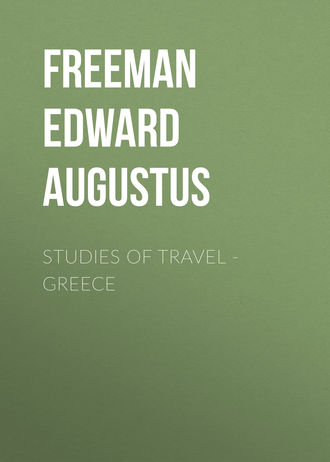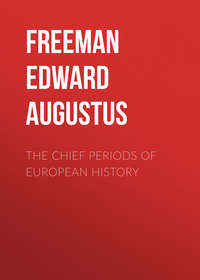 полная версия
полная версияStudies of Travel - Greece

Edward A. Freeman
Studies of Travel - Greece
Preface
The papers that have been brought together in these small volumes are the results of three several journeys made by my father in Greece and Italy. He visited Greece for the first time in 1877, but of the papers written in that year, which appeared in the Saturday Review, only those on Corfu have been reprinted. They form part of the volume of Sketches from the Subject and Neighbour Lands of Venice, in the preface to which work the hope was held out that some out of many papers on the more distant Greek lands might one day be put together. It has been thought that these papers will not prove the less welcome that they must now lack the re-casting that my father would undoubtedly have given to them. Since his Greek journey was made, fresh light has been thrown on many points by the German excavations at Olympia as well as by those conducted by the Greeks themselves on the Athenian Akropolis, at Eleusis and elsewhere.
The papers on the two Italian journies of 1881 and 1883 also stand as they were written with the exception of a few verbal alterations which have seemed needful in such a reproduction of what was originally intended for the columns of a newspaper.
I have to thank the editors of the Saturday Review, the Guardian, and the Pall Mall Gazette for their courtesy in allowing the reprint of these articles which have appeared in their pages.
Florence Freeman,Alicante:
January 17, 1893.
Round Peloponnêsos
The traveller who enters the older Hellenic world by way of Corfu, and who leaves that island by an evening steamer, will awake the next morning within a region which even modern geography and politics allow to be wholly Hellenic. As long as light serves him, he still keeps along the channel which divides free Corfu from enslaved Epeiros; night cuts him off from the sight of the mouth of the Ambrakian Gulf, and of the point where modern diplomacy has decreed that Greek nationality shall, as far as diplomacy can affect such matters, come to an end. The next morning’s dawn finds him off the mouth of the outer Corinthian Gulf. To the east he is shown the position, on one side, of Patras, the old Achaian city which St. Andrew a thousand years back so manfully defended against Slave and Saracen, on the other side, of Mesolongi, whose fame belongs wholly to our own day. We call up the two sieges — the one where the civilian Mavrokordatos, the one hero whom the Fanariot aristocracy gave to the cause of Greece, beat back the Ottoman from its mud walls; the other made more famous still by that fearful sally of the besieged, when, like the men of Ithômê or Eira, they cut their way through the thickest bayonets of the Egyptian invader. There may be some to whom the record of those great deeds may be an unknown tale, but who may yet remember how Mesolongi saw the last and worthiest days of the life of Byron. Of Patras, of Mesolongi, however, we have hardly so much as a distant glimpse; we are told where they are, and that is all. For a while, too, the Peloponnesian coast itself is more distant and less attractive than the islands to the west of it, now parts, no less than Peloponnêsos itself, of the Hellenic realm. Yet we may remember that, as we pass by the Eleian shore — Βουπράσιόν τε καὶ Ἤλιδα δῖαν, while we are shown where lies the path to Olympia, we are now passing by the true Morea, the land which once distinctively bore that name before it gradually spread over the whole peninsula. The mainland as yet hardly attracts us. The dawn has hardly given way to full sunlight as we see Ithakê fade away in the distance, while Kephallênia lifts her bold height full before us. Half the Odyssey rushes on our memory, and the memory of some may be English enough to remember the happy description of our own Ælfred, how Aulixes — his form of Odysseus— was king of two kingdoms, Ithakê and something else, which he held under the casere Agamemnôn. A happy power of seeing the analogies between the institutions of his own day and those of remote ages enabled the West-Saxon King who had seen Rome in his childhood, the prince under whom English, Welsh, and Danish rulers held their kingdoms, to understand the imperial position of the lord of many islands and of all Argos better perhaps than it was understood again till the light of comparative research broke on our own age. We pass by, hoping for some future chance of prying into the geographical difficulties of the Homeric Ithakê, but feeling at all events that it is a stirring moment when we look on islands which legend at least pictures to us as the realm of Odysseus, and in seeing which we may take in a lesson of comparative politics from the noblest ruler of our own people.
Still the insular side is more prominent than the peninsular. Zakynthos, Zante, the isle of flowers, the flower of the Levant, plays no great part in Hellenic history, but as the height of Kephallênia passes away, the beautiful island, with its hills, its valleys, its city spread along the shore and climbing up the mountain-side, is the chief object to draw the eye to itself as long as it remains in sight. It is not till we have passed the curve of the Kyparissian gulf, not till we have passed the great islands, that the coast itself becomes the main object of study. For a study it is, whether in geography, in history, or in simple contemplation of the grand coast-line with the inland mountains soaring above all, and changing their seeming geographical position with the various shiftings of the vessel’s course. The snow-capped height of Pentedaktylos, once Ta getos, rises over all, seen from this point and from that, but always suggesting the same thought, and commonly bringing with its mention the same answer — There lies Sparta. The shape of southern Peloponnêsos lends itself well to a coasting survey of this kind. The three long fingers in which the peninsula ends, and the two deep gulfs between them, allow the whole country to be seen as in a map, and allow most objects to be seen from several points, and therefore to assume several shapes. From Zante to Cerigo — a name which can hardly be a corruption, but which must have by some process supplanted the earlier Kythêra — the coast-line is everything. Islands there are not a few, but they are small islands near to the coast, entering into the general scenery of the coast, and, near as they are, some of them were, like Cerigo itself, part of the dominion of Venice and of the powers which stepped into the place of Venice. Any map earlier than the cession of the Ionian Islands to Greece will show a boundary passing between the coast and several islands which seem to lie within a stone’s throw of it. Along the whole line, the possessors of the mainland, first Ottoman, then Greek, were hemmed in, and as it were blockaded, by a series of floating outposts planted off their shores by the successive possessors of the Seven Islands. One is apt, in using a map of the days of “the Protection,” to mistake the odd-looking frontier drawn in the sea for the probable course of the steamer. Now the frontier is gone; the great islands and the tributary islets all form part of the same kingdom as the mainland. All are now Hellenic in every sense, yet the most striking object in the journey brings forcibly to the mind how recent and artificial is the modern use of the Hellenic name. Tainaros runs far into the sea, as it did when the temple of Poseidôn crowned its height, and when the Helot refugee sought shelter under his protection from his Spartan master. Behind it rises Pentedaktylos, or rather Tainaros carries on Pentedaktylos into the sea. All the folk of those heights called themselves Hellênes in the old days, and all call themselves Hellênes now. But in those intermediate days which are painted for us by the Imperial geographer, the name of Hellênes was confined to a very narrow range indeed. The only Hellênes whom Constantine knew, the only people who were so called by their neighbours — for they do not seem to have borne that name on their own tongues — were the men of Tainaros, the wild and, down almost to our own day, unconquerable land which had in his time already got the name of Maina. These, he tells us pointedly, were no Slaves, distinguishing them from their Slavonic neighbours on Pentedaktylos itself. They were called Hellênes, but it was not in distinction from the Slaves that they were so called. They were, he says, descendants of the old Romans. Let no one dream of colonists from the Palatine or even from the Aventine. The “old Romans” of Constantine are what we should call Greeks, Hellênes, in this particular case the Eleutherolakônes, the people of the Lakonian towns set free under Roman patronage from their subjection to Sparta. The Roman, the subject of the Empire, is distinguished from the Slave, but these particular Romans bore the Hellenic name because they, or at least their immediate forefathers, clave to the Hellenic Gods. Late in the ninth century, till the apostolic zeal of the first Basil brought them within the Christian fold, the men of Maina still sacrificed to Poseidon and the other gods of their fathers. Thus they were Hellênes, Hellênes in the sense which the name bears in the New Testament, Hellênes in the sense in which Jovianus of Korkyra despoiled the temples and altars of the Hellênes to raise the church of the Panagia. No piece of nomenclature is more instructive than this. The name of Hellên would have been an insult to the Orthodox Roman of the purest Hellenic blood. It clave to the men of Tainaros only because they clave to Hellenic idols. Yet, whether as Eleutherolakônes, as Hellênes, or as Mainotes, the men of Tainaros have for many ages continued to have a name of their own.
The most historic spot, however, in the whole voyage is reached some while before we come to Tainaros. Pentedaktylos, the specially Slavonic mountain of Constantine’s day, suggests its Hellenic neighbours, and Pentedaktylos comes in sight before we have doubled the first of the three great Peloponnesian promontories. Among the islands which lie along the coast is one which at first sight is hardly known to be an island. Sphagia keeps close watch over the haven of Navarino — watch so close that the whole length of Sphagia has to be passed before we see the narrow mouth which leads into the landlocked harbour which saw the last great sea-fight fought in Hellenic waters. Sphagia is there; Navarino is there; but some have ventured to doubt whether Sphagia is Sphaktêria, and whether Navarino is Pylos. Some have held that, in the changes of the coast, what was Sphaktêria has now become part of the mainland, and that the island which we now see is not that where Sparta endured her first great humiliation, where Kleôn and Dêmosthenês, in the teeth of all expectation, of every seeming impossibility, brought back “the men,” the Spartan captives, in triumph to the harbour of Peiraieus. Such questions as this cannot be settled by one who sees the sites only as the power of steam hurries him alongside of them. In this general view the question is of no great moment. There is the coast, whatever may be the exact spot, where the legend makes Nestor entertain Têlemachos, and whence Têlemachos and Peisistratos drove a carriage and pair in two days from Pylos to Sparta. Now whether Têlemachos and Peisistratos be real men or mere creations of fancy, the road at least is no creation of fancy. The poet would not have ventured to make his heroes perform such a drive, as something perfectly easy and usual unless Peloponnêsos had been better supplied with roads in his day than it is in our own. Here then we get a kind of history out of the legend. There again is the coast, whatever may be the exact spot, where happened the most remarkable episode of the Peloponnesian war, the occupation of Pylos-the Lacedæmonian Koryphasion-and all that came of it. With yet more certain knowledge of the exact spot, we can point to the harbour where the fetters of Greece were broken, and where the might of Turk and Egyptian fell before the combined powers of Orthodox Russia, Catholic France, and Protestant England.
We pass on from promontory to promontory, the gulfs taking different shapes and bringing different objects into sight at every moment. At last
Slow sinks, more lovely ere his work is done, Behind Morea’s hills the setting sun.Pentedaktylos and Tainaros are lighted up, as the sun, in Greek phrase, reigns (βασιλεύει) over the heavens from which he is about to sink into his golden cup. Cerigo and Malea are seen only by the help of the lesser lights, but we can still see the long harbourless coast of Lakonia stretching away to the Argolic lands, and we have found out too the site of the Lakonian Epidauros, more famous in later days as Monembasia. As we woke one morning about the islands of the West, so we wake the next along the islands of the Ægæan. Tênos, Andros, Mykonos, Mêlos, Naxos, Dêlos itself, come into view at different points, till we stand before the haven which has in modern times made itself the centre of the commerce and navigation of these seas. The isle of Syros stands before us, bleak and barren. There is the steep conical hill, covered, every inch of it, with houses rising up to the church of St. George, the cathedral church of Latin Syra, the mediæval city, the city of refuge in days when men were driven to fall back on the hill-fortresses of the earliest day. On the shore, on the site of ancient Syros, but spreading over the adjoining hills, is the modern Hermoupolis, the busy mart of all the islands. Another night, a fair starry night, on the deep, and we reach the goal of the whole pilgrimage. Day has hardly dawned enough to see clearly Sounion and its marble columns, but there, however dimly seen, is the shore of Attica, and the thought comes that came into the heart of the sailors of Salaminian Aias, that before long
προσείποιμ’ αν Ἀθάνας.The Athenian Akropolis
It may not seem easy to say anything new on so well-worn a subject as Athens and her Akropolis, but of all subjects in the world there is none which has been more steadily looked at from a single inadequate point of view. It is moreover a subject whose history is not yet ended, and which supplies new points of view by the fact that new pages in its history are still happening. Nowhere is the unity of history more needed to be taught as a practical lesson than on the spot where we may fairly say that the political history of the world begins. There, on the spot whose history begins before the beginning of recorded history, we feel perhaps more keenly than anywhere else how blind and narrow is the way in which the history of that spot has been so commonly looked at, how large a part of the true interest, the true life, of the spot is lopped away, if we look only at some two or three centuries of its long and varied history. In the city of Athens, as a whole, we are painfully struck by the glaring contrast of extreme antiquity and extreme newness. There are buildings of yesterday; there are buildings of a thousand years back; there are buildings of two thousand years back, but the three classes stand out in marked and indeed unpleasant contrast to one another. There are no intermediate links such as there are at Rome, binding the great classes of objects together, and making them all fit into their places as members of one unbroken series. Hence, while at Rome we never forget that we are at Rome, at Athens we may sometimes forget that we are at Athens, That so it is no fault of the Athenians, old or new. It comes of the fact that the Turk once ruled in Athens, and therefore had to be driven out of Athens; while, as the Turk never ruled in Rome, he never had to be driven out of Rome. If this is true of the city in general, it is far less true of the Akropolis. There we can never forget that we are in Athens; and, if we use our eyes aright, we can never forget that the Athens in which we stand did not exist, as some seem to fancy, only for two or three centuries two thousand years back, but that its long history spans the whole range from our first glimpses of civilized Europe down to the warfare in which men still living have borne a part. It is but a narrow view of the Akropolis of Athens to look on it simply as the place where the great works of the age of Periklês may be seen as models in a museum. A truer and a wider view will begin earlier and will go on later. The Parthenôn and the Propylaia are but the records of one stage, though doubtless the most brilliant stage, in the history of a city which ought equally to number among its records the primæval wall which was venerable and mysterious in the days of Thucydides and the bulwarks which were raised by the last Odysseus in warfare with the Turkish oppressor. In the eye of the true historian those earliest and those latest records, and the records of the long ages which passed between them, all have, perhaps not all an equal value, but at least value enough to stamp them all as alike parts of the history of the city, all alike entitled to respect and veneration from every one in whose eyes the history of the city is precious. On the hill of the Akropolis and its buildings the whole history of Athens, from its earliest to its latest days, has been clearly written, and there it may still be clearly read wherever the barbarism of classical pedantry has not wiped out the record. The primæval wall, the wall of Themistoklês, the wall of Kimôn, all come within the charmed period. No one is likely to damage them. It needs, however, a wider view than that of the mere student of the writings, the mere admirer of the art, of two or three arbitrarily chosen centuries, to take in the full meaning even of the works of those arbitrarily chosen centuries. Those remains of the earliest masonry, for which we have to search behind the great buildings of the days of the democracy, those stones which rival aught at Argos or at Tiryns, have a tale to tell such as Argos and Tiryns cannot tell. Why was Athens Athens? How came that one city to fill that particular place in the world’s history which no other city ever did fill? In the Homeric catalogue Athens stands alone; all Attica is already Athens, while every other part of the catalogue is crowded with the names of those smaller towns many of which passed away before recorded history begins. Marathon and Eleusis find no place in the great record. The work had already been done, be the name of the doer of it Thêseus or any other, which made Athens all that Athens was — which fused together into one commonwealth the largest extent of territory, the largest number of citizens which, according to Greek political ideas, could act together as members of a single commonwealth. Athens could become all that she did become, because, in an unrecorded age, in an age of which those rude stones at least are the only record, all Attica became Athens. To that great revolution, none the less certain because in its own nature unrecorded, it is alike owing that Athens in one age could rear the trophy of Marathôn, and that in another she was chosen to be the head of regenerate Greece. The oldest wall — we may call it the wall of Thêseus — and the latest wall of Odysseus are but the earliest and the latest pages of one story, bound together by the direct tie of cause and effect.
If then, fully to take in the historic greatness of the Athenian Akropolis, we must look to facts and their records alike far earlier and far later than the days of Periklês, the works of the days of Periklês lose half their value if we look at them simply as the works of the age of Periklês, and do not bear in mind the long ages, the stirring events, of their later history. The house of Athênê is emphatically the Parthenôn. When Dêmêtrios the Besieger was lodged in its opisthodomos, the satirical remark was made that he and his following were by no means fitting guests for its virgin owner. It should, however, be remembered that that ancient temple has remained the house of the Virgin under three distinct forms of worship. The classical purist might disdain to notice — or, if he noticed, he might be eager to wipe out such a memory — that on the walls of the cella may still be seen the paintings, the εἰκόνες of another creed, another form of art, from those of Pheidias and Iktinos. Yet those painted forms tell us of one of the great moments in the history of South-Eastern Europe — one might rather say one of the great moments in the history of the world. It speaks of the day when the New Rome was again queen of all the nations, from Crete to the Danube, from the Euphrates to the Bay of Naples, when the Slayer of the Bulgarians, in the moment of his triumph, chose, out of all the holy places of his Empire, the church of the Panagia on the rock of Athens as the scene of his thanksgiving for the great salvation which his arms had wrought. We stand on the rock, and run over in our minds the long ages between Periklês returning from the recovery of Samos, and Basil returning from the recovery of Ochrida. We look down upon the lands which endured the ravages of the last Philip in the cause of Rome, on the city which endured the storm of Sulla in the cause of Mithridatês. We look down on the works of Hadrian and the works of Hêrôdês, and the eye wanders to a spot where the monument of a Syrian prince is the most prominent object on an Athenian hill. We think how long Athens remained the school of Rome, how the Goth turned away from her walls, how Justinian at once strengthened her as a fortress and took away from her her crown as the seat of heathen philosophy and heathen worship. Yet we mark the slight lingering of ancient memories which, in re-dedicating her ancient temples to the new faith, still kept a certain analogy between their older and their newer functions. We mark how the Parthenôn still remained the Parthenôn; how the temple of the heathen warrior Thêseus became the church of the Christian warrior George. We think — Athens is not expressly mentioned in the tale, but she can hardly be deemed to have lagged behind her fellows — how the Greeks, the Ἑλλαδικοί, as the Byzantine writer scornfully calls them, set forth on their strange and bootless errand of delivering Constantinople from Isaurian and Iconoclastic rule. Below us lie the churches of Eirênê, monuments of days when Athens and Constantinople were united in a common orthodoxy, when Athens had given an Empress to the Eastern world, and when men again dreamed of a union of East and West by the marriage of an Athenian and a Frank. All these memories lead up naturally to the great scene of Basil’s day of triumph, when a prince who might be deemed at once Roman, Greek, and Slave, chose Athens and her still abiding Parthenôn for the greatest ceremony of his long reign of warfare and of victory. We pass on to another age. The spirit which will hardly endure the memory of a Greek-speaking Cæsar on the holy hill of Athênê will find times even less to its taste when an Italian prince, in his will drawn up in the Italian tongue, bequeaths the city of Athens to the Church of St. Mary. Things had indeed changed, alike from the days of Periklês and from the days of Basil, yet Athens under the French and Italian Dukes had in some sort come back nearer to her ancient place than when she beheld the thanksgiving of the Macedonian Emperor. Athens, by that name, was again one of the powers of the world, no longer a mere province of Rome, either in her older or her newer seat. It was indeed a time of foreign rule. A Latin Duke had made his palace in the Propylaia of Periklês; a Latin Bishop had displaced the Orthodox rite of Basil’s day in the church which was still the Parthenôn. Yet those were days when Athens was the seat of a brilliant court, when the fame of her princes was spread through Europe. The formula of our own Shakespeare, so strange in the ears of many, when he speaks of Thêseus Duke of Athens, is a mark of days when her Kings and Archons had been forgotten, but the memory of her Dukes still lived in the minds of men. But the wanton barbarism of classical exclusiveness will not endure the memory or the record or the monuments of days like these. Only yesterday the tower of the Dukes of Athens was standing. Its stern and heavy mass well broke the horizontal lines of the Greek architecture, and gave to the whole group somewhat of that outline which the hill of Laon has, and which the hill of Athens has not. But the tower was late; it was barbarous; it did not belong to the two or three favoured ages; it was a reminder of times which the exclusive votaries of those two or three favoured ages would fain wipe out from the records of mankind. Mr. Mahaffy, indeed, who cannot distinguish between the taking of Constantinople in 1204 and the taking of Athens in 1687, believed that Morosini had found time to build this massive tower during the few weeks of his occupation. Mr. Mahaffy, who looks on the Akropolis as so sacred that it was a sin to bombard it, even to drive the Turks out of it — who seems to think freedom and national being something of less moment than the preservation of this or that statue or column — calls for its destruction in his text and crows over its completed destruction in a note. Of this piece of wanton barbarism Dr. Schliemann must bear the blame. Who, if any, were his Greek accomplices, we have forborne to ask. But the tower is gone; a most striking memorial of one age in the history of Athens has been swept away, under the paltry pretext that inscriptions might be found among its materials. By a righteous Nemesis, when the destroyers had finished their work of havoc, they found nothing to reward them.







